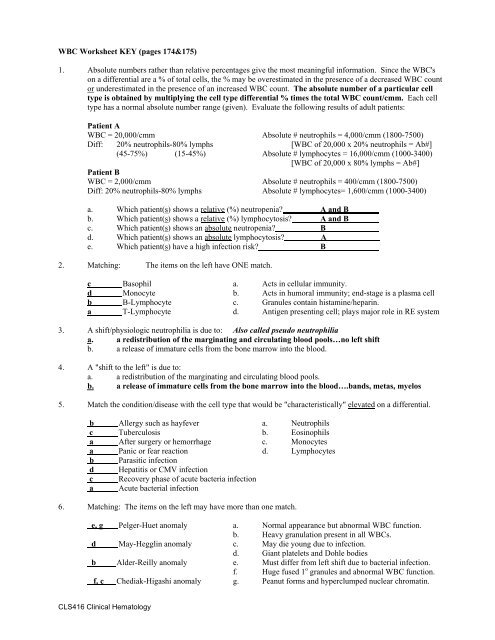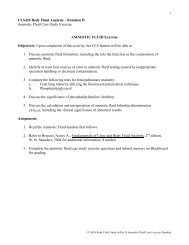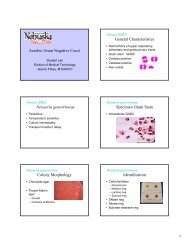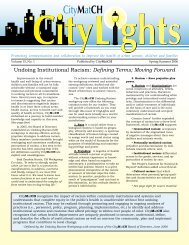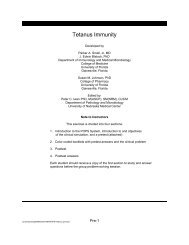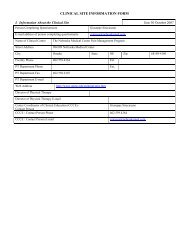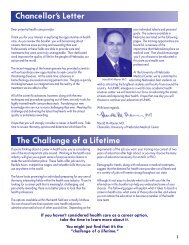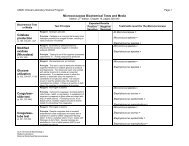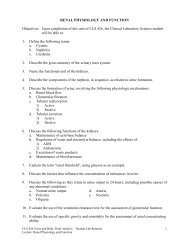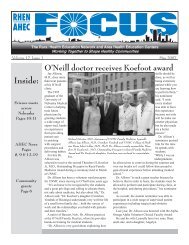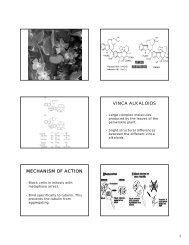WBC Worksheet KEY (pages 174&175;) 1. Absolute ... - UNMC
WBC Worksheet KEY (pages 174&175;) 1. Absolute ... - UNMC
WBC Worksheet KEY (pages 174&175;) 1. Absolute ... - UNMC
Create successful ePaper yourself
Turn your PDF publications into a flip-book with our unique Google optimized e-Paper software.
<strong>WBC</strong> <strong>Worksheet</strong> <strong>KEY</strong> (<strong>pages</strong> 174&<strong>175</strong>)<strong>1.</strong> <strong>Absolute</strong> numbers rather than relative percentages give the most meaningful information. Since the <strong>WBC</strong>'son a differential are a % of total cells, the % may be overestimated in the presence of a decreased <strong>WBC</strong> countor underestimated in the presence of an increased <strong>WBC</strong> count. The absolute number of a particular celltype is obtained by multiplying the cell type differential % times the total <strong>WBC</strong> count/cmm. Each celltype has a normal absolute number range (given). Evaluate the following results of adult patients:Patient A<strong>WBC</strong> = 20,000/cmm <strong>Absolute</strong> # neutrophils = 4,000/cmm (1800-7500)Diff: 20% neutrophils-80% lymphs [<strong>WBC</strong> of 20,000 x 20% neutrophils = Ab#](45-75%) (15-45%) <strong>Absolute</strong> # lymphocytes = 16,000/cmm (1000-3400)[<strong>WBC</strong> of 20,000 x 80% lymphs = Ab#]Patient B<strong>WBC</strong> = 2,000/cmm <strong>Absolute</strong> # neutrophils = 400/cmm (1800-7500)Diff: 20% neutrophils-80% lymphs <strong>Absolute</strong> # lymphocytes= 1,600/cmm (1000-3400)a. Which patient(s) shows a relative (%) neutropenia? A and Bb. Which patient(s) shows a relative (%) lymphocytosis? A and Bc. Which patient(s) shows an absolute neutropenia? Bd. Which patient(s) shows an absolute lymphocytosis? Ae. Which patient(s) have a high infection risk? B2. Matching: The items on the left have ONE match.c Basophil a. Acts in cellular immunity.d Monocyte b. Acts in humoral immunity; end-stage is a plasma cellb B-Lymphocyte c. Granules contain histamine/heparin.a T-Lymphocyte d. Antigen presenting cell; plays major role in RE system3. A shift/physiologic neutrophilia is due to: Also called pseudo neutrophiliaa. a redistribution of the marginating and circulating blood pools…no left shiftb. a release of immature cells from the bone marrow into the blood.4. A "shift to the left" is due to:a. a redistribution of the marginating and circulating blood pools.b. a release of immature cells from the bone marrow into the blood….bands, metas, myelos5. Match the condition/disease with the cell type that would be "characteristically" elevated on a differential.b Allergy such as hayfever a. Neutrophilsc Tuberculosis b. Eosinophilsa After surgery or hemorrhage c. Monocytesa Panic or fear reaction d. Lymphocytesb Parasitic infectiond Hepatitis or CMV infectionc Recovery phase of acute bacteria infectiona Acute bacterial infection6. Matching: The items on the left may have more than one match.e, g Pelger-Huet anomaly a. Normal appearance but abnormal <strong>WBC</strong> function.b. Heavy granulation present in all <strong>WBC</strong>s.d May-Hegglin anomaly c. May die young due to infection.d. Giant platelets and Dohle bodiesb Alder-Reilly anomaly e. Must differ from left shift due to bacterial infection.f. Huge fused 1 o granules and abnormal <strong>WBC</strong> function.f, c Chediak-Higashi anomaly g. Peanut forms and hyperclumped nuclear chromatin.CLS416 Clinical Hematology
7. Completion:a. Leukemia is a proliferation of malignant cells in the bone marrow, whichmay involve the blood, and is initially a systemic disease.b. Lymphoma is a proliferation of malignant cells in solid lymphoid tissues andis initally a localized disease; some types may spread to the bone marrow and blood.c. Burkitt's lymphoma and Inf Mononucleosis are associated with the Epstein-Barr (EBV) virus.Hodgkin’s disease is also associated with EBVd. Peripheralized non-Hodgkin's lymphomas are characterized by the presence ofRieder/cleftedcells in the blood after they spread to the bone marrow (and blood).e. The two most common causes of death in acute leukemia are: infection (↓ neutrophils) andbleeding (↓ platelets) .8. TRUE or FALSE. Chronic leukemias have > 30% blasts in the bone marrow. 30% blasts in the bone marrow.Normal is


